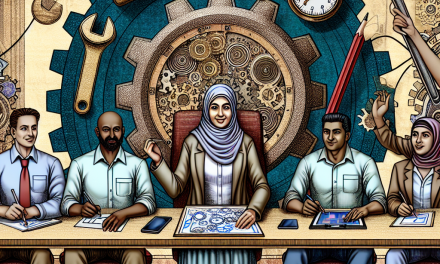Table of Contents
- Introduction
- The Rise of Arab Leaders in Animation: A Creative Revolution
- Exploring the Impact of Arab Animation Leaders on Global Entertainment
- Unveiling the Unique Perspectives of Arab Animation Leaders in Storytelling
- Arab Animation Leaders: Pioneers of Cultural Representation in the Animation Industry
- Q&A
- Conclusion
Unleashing Arab creativity through animated wonders.
Introduction
“Arab Leaders in Animation: Bringing Creativity to Life” showcases the remarkable talent and innovation of Arab animators who have made significant contributions to the world of animation. This introduction explores the achievements and impact of these visionary artists, highlighting their ability to bring stories to life through their unique cultural perspectives and artistic styles. From groundbreaking films to captivating television series, Arab leaders in animation have not only entertained audiences worldwide but have also played a crucial role in promoting diversity and representation within the industry.
The Rise of Arab Leaders in Animation: A Creative Revolution

The world of animation has long been dominated by Western countries, with Hollywood serving as the epicenter of creativity and innovation. However, in recent years, there has been a noticeable rise in Arab leaders in the field of animation, bringing a fresh perspective and unique storytelling to the industry. This creative revolution is not only reshaping the landscape of animation but also challenging stereotypes and showcasing the immense talent that exists in the Arab world.
One of the key factors contributing to the rise of Arab leaders in animation is the increasing accessibility of technology and education. With the advent of digital tools and software, aspiring animators in the Arab world now have the means to bring their ideas to life. Additionally, the establishment of specialized animation schools and programs has provided a platform for young talents to develop their skills and gain exposure to international standards of animation.
The Arab animation industry has also benefited from the growing support of governments and organizations. Recognizing the potential of animation as a cultural and economic asset, many Arab countries have implemented initiatives to promote and nurture local talent. For instance, the Dubai International Film Festival has been instrumental in providing a platform for Arab animators to showcase their work and connect with industry professionals. Similarly, the Abu Dhabi Film Commission has been actively supporting the development of animation projects through funding and mentorship programs.
Another significant factor contributing to the rise of Arab leaders in animation is the rich cultural heritage and storytelling traditions of the Arab world. Arab animators are drawing inspiration from their own history, folklore, and mythology, creating narratives that resonate with both local and global audiences. By infusing their work with elements of Arab culture, these animators are challenging the dominant Western narratives and offering a fresh perspective on storytelling.
One notable example of an Arab leader in animation is Saudi Arabian director Haifaa Al-Mansour. Al-Mansour gained international acclaim with her feature film “Wadjda,” which was the first-ever Saudi Arabian entry for the Best Foreign Language Film category at the Academy Awards. Al-Mansour’s success has not only opened doors for other Arab animators but has also shattered stereotypes and showcased the immense talent that exists in the Arab world.
The rise of Arab leaders in animation is not without its challenges. Despite the progress made, there is still a lack of representation and diversity in the industry. Arab animators often face barriers in terms of funding, distribution, and access to international markets. However, with the increasing recognition and support for Arab animation, these barriers are slowly being dismantled, paving the way for a more inclusive and diverse industry.
In conclusion, the rise of Arab leaders in animation is a testament to the immense talent and creativity that exists in the Arab world. Through the accessibility of technology, government support, and a rich cultural heritage, Arab animators are reshaping the industry and challenging stereotypes. While there are still challenges to overcome, the future looks promising for Arab animation, with the potential to create a more inclusive and diverse landscape for storytelling. As the world continues to embrace the creativity and innovation of Arab animators, we can expect to see even more groundbreaking work from this emerging group of leaders in animation.
Exploring the Impact of Arab Animation Leaders on Global Entertainment
Arab Leaders in Animation: Bringing Creativity to Life
Exploring the Impact of Arab Animation Leaders on Global Entertainment
Animation has become an integral part of the global entertainment industry, captivating audiences of all ages with its ability to bring stories and characters to life. While the field of animation has traditionally been dominated by Western countries, there has been a significant rise in the influence of Arab leaders in this creative realm. These talented individuals have not only brought their unique perspectives and cultural experiences to the forefront but have also made a lasting impact on the global animation landscape.
One of the most prominent Arab leaders in animation is Hayao Miyazaki, the renowned Japanese filmmaker and co-founder of Studio Ghibli. Miyazaki’s work, such as “Spirited Away” and “My Neighbor Totoro,” has captivated audiences worldwide with its imaginative storytelling and stunning visuals. His ability to seamlessly blend elements of fantasy and reality has made him a revered figure in the animation industry, inspiring countless animators, both in the Arab world and beyond.
Another influential Arab leader in animation is Marjane Satrapi, an Iranian-born French filmmaker and graphic novelist. Satrapi gained international recognition with her critically acclaimed animated film “Persepolis,” which tells the story of her own experiences growing up in Iran during the Islamic Revolution. Through her unique visual style and powerful storytelling, Satrapi has shed light on the rich cultural heritage of the Arab world and challenged stereotypes and misconceptions.
In addition to individual leaders, Arab animation studios have also made significant contributions to the global entertainment industry. One such studio is Barajoun Entertainment, based in Dubai. Founded by Ayman Jamal, Barajoun Entertainment has produced several animated films, including “Bilal: A New Breed of Hero.” This groundbreaking film, inspired by the life of Bilal ibn Rabah, an Ethiopian slave who became a prominent figure in Islamic history, showcases the studio’s commitment to telling diverse and culturally significant stories.
The rise of Arab leaders in animation has not only brought a fresh perspective to the industry but has also opened doors for aspiring animators from the Arab world. With the increasing availability of animation programs and resources, young Arab artists now have the opportunity to showcase their talent and make their mark on the global stage. This newfound recognition has also led to collaborations between Arab and Western animation studios, fostering a cross-cultural exchange of ideas and techniques.
However, it is important to acknowledge the challenges that Arab leaders in animation face. The animation industry, like many creative fields, can be highly competitive and demanding. Arab animators often have to navigate cultural and societal expectations while pursuing their artistic ambitions. Despite these obstacles, their perseverance and dedication have allowed them to break barriers and create groundbreaking work that resonates with audiences worldwide.
In conclusion, the impact of Arab leaders in animation on the global entertainment industry cannot be overstated. Through their unique storytelling, visual styles, and cultural perspectives, these talented individuals have brought creativity to life and challenged the status quo. Their contributions have not only enriched the animation landscape but have also paved the way for future generations of Arab animators to make their mark. As the world continues to embrace the power of animation, it is crucial to recognize and celebrate the diverse voices that shape this vibrant art form.
Unveiling the Unique Perspectives of Arab Animation Leaders in Storytelling
Arab Leaders in Animation: Bringing Creativity to Life
Animation has long been a powerful medium for storytelling, captivating audiences of all ages with its ability to transport us to fantastical worlds and bring characters to life. While the animation industry has traditionally been dominated by Western countries, there is a growing recognition of the unique perspectives and talents of Arab animators. Arab animation leaders are making their mark in the industry, bringing their rich cultural heritage and creative storytelling techniques to the forefront.
One of the key strengths of Arab animation lies in its ability to blend traditional storytelling with modern techniques. Arab culture has a long and rich tradition of oral storytelling, with tales passed down through generations. This tradition is now being translated into the world of animation, with Arab animators infusing their work with the same depth and richness found in traditional storytelling. By drawing on their cultural heritage, Arab animators are able to create narratives that resonate with audiences on a deeper level, while also introducing the world to the beauty and diversity of Arab culture.
Another unique aspect of Arab animation is its focus on social and political issues. Arab animators are not afraid to tackle complex and sensitive topics, using animation as a platform to address issues such as social inequality, gender roles, and political unrest. By using animation as a medium for social commentary, Arab animators are able to reach a wider audience and spark important conversations. This approach has garnered international recognition, with Arab animated films and series receiving critical acclaim and winning awards at prestigious festivals around the world.
In addition to their storytelling prowess, Arab animators are also pushing the boundaries of animation techniques. They are embracing new technologies and experimenting with different styles and aesthetics, resulting in visually stunning and innovative works. This willingness to explore and push the limits of animation has earned Arab animators a reputation for their technical expertise and artistic vision. As a result, they are increasingly sought after by international studios and production companies, further cementing their place in the global animation industry.
Arab animation leaders are also playing a crucial role in nurturing and mentoring the next generation of animators. They are actively involved in training programs and workshops, sharing their knowledge and expertise with aspiring animators. By passing on their skills and experiences, Arab animators are ensuring that the industry continues to grow and thrive in the region. This commitment to education and mentorship is not only benefiting the local animation community but also contributing to the overall development of the Arab animation industry.
In conclusion, Arab animation leaders are bringing a fresh perspective to the world of animation, infusing their work with cultural richness, social commentary, and technical innovation. Their unique storytelling techniques, combined with their willingness to tackle complex issues, have earned them international recognition and acclaim. As the Arab animation industry continues to grow, it is clear that Arab animators are making a significant impact on the global animation landscape. With their creativity and passion, they are bringing new life to the art of animation and captivating audiences around the world.
Arab Animation Leaders: Pioneers of Cultural Representation in the Animation Industry
Arab Animation Leaders: Pioneers of Cultural Representation in the Animation Industry
The animation industry has long been dominated by Western countries, with characters and stories primarily reflecting Western culture. However, in recent years, Arab animation leaders have emerged as pioneers in bringing cultural representation to the forefront of the industry. Through their creativity and innovation, these leaders are reshaping the landscape of animation and providing a platform for Arab voices to be heard.
One of the key figures in this movement is Randa Chahal Sabbag, a Lebanese filmmaker and animator. Sabbag’s work often explores themes of identity, displacement, and the struggles faced by Arab women. Her animated films, such as “A Girl’s Gotta Do What a Girl’s Gotta Do” and “The Kite,” have received critical acclaim for their unique storytelling and powerful messages. Sabbag’s ability to tackle complex issues through animation has paved the way for other Arab animators to follow suit.
Another prominent Arab animation leader is Ayman Jamal, a Saudi Arabian filmmaker and producer. Jamal is the co-founder of Barajoun Entertainment, the first animation studio in the Arab world. His film “Bilal: A New Breed of Hero” made history as the first animated feature film from the Middle East to be released globally. The film tells the story of Bilal ibn Rabah, an African slave who becomes a hero in the early days of Islam. Through his work, Jamal aims to challenge stereotypes and showcase the rich history and culture of the Arab world.
In addition to individual animators, organizations such as the Dubai-based Cartoon Network Studios Arabia are also playing a crucial role in promoting Arab talent in the animation industry. The studio, a collaboration between Turner Broadcasting System and the Middle East Media and Entertainment Centre, aims to develop original content that reflects Arab culture and values. By providing a platform for Arab animators to showcase their work, Cartoon Network Studios Arabia is helping to diversify the animation industry and break down cultural barriers.
The rise of Arab animation leaders is not only significant for the industry but also for the representation of Arab culture on a global scale. Through their work, these leaders are challenging stereotypes and showcasing the diversity and richness of Arab culture. By telling stories that resonate with Arab audiences, they are also fostering a sense of pride and identity within the Arab community.
Furthermore, the success of Arab animation leaders is inspiring a new generation of animators and filmmakers. As more Arab voices are heard in the industry, the possibilities for storytelling and representation are expanding. This increased representation is not only important for Arab audiences but also for promoting cultural understanding and appreciation among a global audience.
However, challenges still remain for Arab animators in the industry. Limited funding and resources, as well as a lack of infrastructure, can hinder the growth and development of Arab animation. Additionally, the dominance of Western animation in the global market can make it difficult for Arab animators to gain recognition and distribution for their work. Despite these challenges, Arab animation leaders continue to push boundaries and make their mark in the industry.
In conclusion, Arab animation leaders are pioneers in bringing cultural representation to the forefront of the animation industry. Through their creativity and innovation, they are reshaping the landscape of animation and providing a platform for Arab voices to be heard. Their work challenges stereotypes, promotes cultural understanding, and fosters a sense of pride and identity within the Arab community. While challenges remain, the rise of Arab animation leaders is an important step towards a more diverse and inclusive animation industry.
Q&A
1. What is “Arab Leaders in Animation: Bringing Creativity to Life”?
“Arab Leaders in Animation: Bringing Creativity to Life” is an event or initiative that aims to showcase and promote the work of Arab leaders in the field of animation.
2. What is the purpose of “Arab Leaders in Animation: Bringing Creativity to Life”?
The purpose of “Arab Leaders in Animation: Bringing Creativity to Life” is to highlight the talent and creativity of Arab animators, and to provide a platform for them to share their work and experiences with a wider audience.
3. Who organizes “Arab Leaders in Animation: Bringing Creativity to Life”?
The organizers of “Arab Leaders in Animation: Bringing Creativity to Life” could be a specific organization, institution, or group dedicated to promoting Arab animation and supporting Arab animators.
4. What are the expected outcomes of “Arab Leaders in Animation: Bringing Creativity to Life”?
The expected outcomes of “Arab Leaders in Animation: Bringing Creativity to Life” could include increased recognition and visibility for Arab animators, networking opportunities, and the potential for collaboration and partnerships within the animation industry.
Conclusion
In conclusion, Arab leaders in animation have played a significant role in bringing creativity to life. Through their innovative storytelling, unique art styles, and cultural representation, they have contributed to the growth and development of the animation industry. Their work not only entertains audiences but also promotes diversity and showcases the rich heritage of the Arab world. With their talent and dedication, Arab leaders in animation continue to inspire and shape the future of this dynamic art form.




